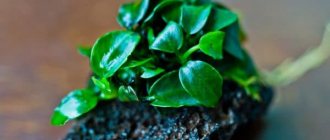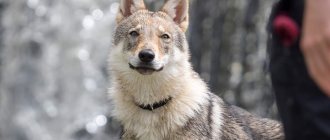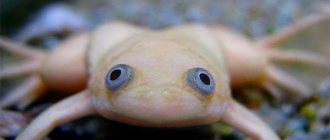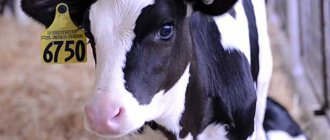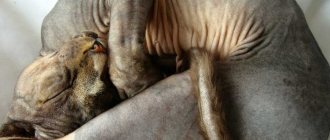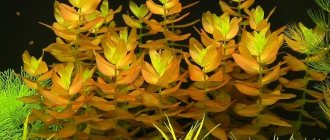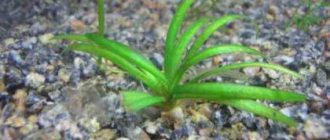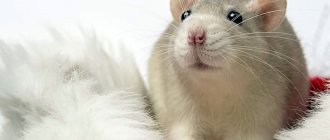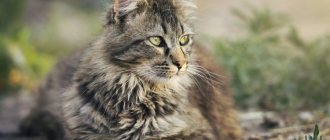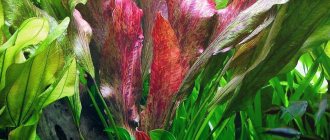To ensure a normal microclimate in the aquarium, you need to plant plants. One of the most popular is Anubias (or as it is also called - “Dwarf”). The first samples of this plant appeared in Europe already in 1899. In the wild, it lives in the tropical rainforests of Africa; grows on the banks of swamps, streams and rivers. The plant can be completely immersed in water or expose its leaves to the air.
Varieties of Anubias
Anubias is growing slowly. It has a creeping rhizome, large leaves of various shapes, and may have thorns. There are many types of plants, but only some of them are artificially bred:
| Name | Description |
| Distributed in the tropics of West Africa. The height in the aquarium can reach 50 centimeters. It is usually planted at the back of the tank. It grows for about 1 year. Water temperature - at least 24°C. Soil thickness - 10-15 cm. |
| Found in African swamps. Plant height is from 25 to 60 centimeters. In aquarium conditions it grows slowly. It can be planted in the central or rear part of the tank. If the plant starts to bloom, it is recommended to remove it from the aquarium, because after flowering the Anubias weakens and withers. |
| Habitat: Western and Central Africa (river banks and wetlands). Height - 25-30 cm. There are several forms:
Growth is slow. |
| The average height is 12 centimeters. Distributed in Nigeria and Congo. Light brown leaves, similar to coffee leaves (hence the name). Placed in the center of the aquarium. Temperature - 22-26°C. When planting in the ground, you need to add sludge and mineral fertilizers. |
| Grows in Guinea, Liberia and Cameroon. It can reach a height of 1 meter, so it must be kept in a large tropical aquarium. It grows very slowly, 3 leaves per year. Temperature - 22-28°C. There should not be a lot of organic matter in the soil. |
| A variety artificially bred by breeders. Height - no more than 4 centimeters. Well suited for planting in small aquariums. |
Herbivorous fish can be kept with most species.
General information
The aquarium plant Anubias is an unassuming tropical flower that grows in damp forests and near bodies of water. These are perennial plants with a slow growth rate and thick, durable rhizomes. The foliage of the flower is hard and leathery, so cichlid holders are often involved in keeping Anubias, since these fish love to feast on aquarium flora. Depending on the variety, the leaves of the flower can be:
- Rounded.
- Heart-shaped.
- Elliptical.
- Arrow-shaped.
- Triangular.
The aquarium plant Anubias can grow both in liquid and above water, so aquarists willingly plant the flower in artificial reservoirs or include it in a florarium in an aquarium. In addition, this type of flora is well suited for keeping in greenhouses and paludariums with increased humidity. Under favorable conditions, Anubias blooms not only in greenhouses, but also in artificial home ponds.
Maintenance and care
Housing conditions should be close to the natural habitat of the plants. To do this, follow certain rules:
- Priming. The layer placed on the bottom of the aquarium must be at least 10 centimeters. The best option is coarse sand and small pebbles. In some cases, it is recommended to add sludge and mineral additives.
- Lighting. The light must be bright, otherwise the plant may wilt. It is recommended to use LED lamps. If you combine warm and cold light, you can achieve an imitation of natural light. Daylight hours are 11-12 hours. Due to excess lighting, the plant may not have time to carry out photosynthesis, and this will lead to the development of harmful algae on the leaves and in the aquarium.
- Water. The optimal temperature is 24 °C. Increasing to 28-30 does not greatly affect the plants, but the temperature should not be allowed to drop below 22°C. The acidity and hardness of water can be anything - they have almost no effect on the life activity of Anubias, but experts recommend soft and minimally acidic water.
It is necessary to get rid of dead parts of the plant in a timely manner, “feed” it with fertilizers and maintain optimal water levels.
Recommendations for selection
When purchasing Anubias for planting, it is important to pay attention to the condition of their leaf blades. The leaves should be fresh, hard, dense, well adjacent to each other. It is worth considering the appearance of the rhizome. It is necessary that it does not decay and is sufficiently developed, without signs of putrefaction.
A number of characteristic diseases and the development of decay are indicated by a specific, unpleasant odor emanating from the plant.
It is immediately recommended to refuse to purchase Anubias that are standing in trays with cold water and have yellowing leaves.
Anubias are attractive amphibious aquarium plants, distinguished by their colors and sizes. A wide variety of species allows each aquarist to choose the most suitable option for himself. This plant, despite its attractive appearance, is not too demanding in terms of requirements for living conditions and is resistant to adverse external factors.
How to plant a plant
Large varieties need to be planted by burying rhizomes in the ground. For small plants, dig in only the roots, leaving the rhizome above the ground. If necessary, the roots are shortened. Holding the long root with tweezers, immerse the plant in the substrate. Tamp down to avoid smearing. Sometimes the top leaves may die off, but this is common - they will grow back after a while.
If you need to plant anubias on driftwood, you should use natural thread, which will dissolve after a certain period of time (when the plant takes root). You need to make sure that the main root is not buried - this can lead to rotting of the plant. Some varieties must be additionally secured, otherwise they will float to the surface.
You can learn more about the planting process in the video:
Description
This is a tropical, green plant with wide leaves of different shapes. Smooth leaves are located along the petiole. There may be small spines on the petiole. Sap veins are visible on the main shoot.
Anubias lives in water or partially protrudes above the surface. Under the right conditions and care, Anubias blooms once a month. Externally, the flowers attract with an unusual appearance. The flowers are similar to callas: they have the same long wedge-shaped petals and a cylindrical spadix, the color is olive or cream.
The plant is either female or male. You can tell a boy from a girl by their flowers: flattened flowers indicate a boy, while round flowers indicate a girl. Women's are located at the bottom, while boys stretch up. After flowering, the fruits ripen - these are small green, round berries with many small seeds inside.
Reproduction
Anubias can be propagated in several ways:
- rhizome division;
- picking;
- cuttings
Reproduction in home aquariums is usually carried out vegetatively: branches or part of the rhizome are separated from the main sprout, which are then transplanted into the tank at a pre-selected location. To strengthen the sprout, it is necessary to use fertilizers.
Emerging shoots can be rooted in two ways:
- Transplant the young plant into the ground (provided that there must be at least 5 leaves per sprout).
- A large leaf is wrapped around a sponge soaked in peat.
It is recommended to carry out propagation with the help of professional aquarists, because it will be difficult for beginners.
Poor growth of Anubias
A slowdown in growth may occur during the cold season or due to unsuitable conditions. The problem can be solved by using mineral fertilizers, adjusting lighting and water parameters. There are several points due to which Anubias cannot be planted in an aquarium:
- impossibility of flowering;
- slower development in soft water environments;
- lack of organic matter in the soil.
Plant development can be inhibited by diseases or improper care. Main diseases:
- yellowing of leaves;
- rust;
- rotting of the stem, leaves or roots;
- sheet deformation;
- freezing of root growth.
Diseases develop due to poor plant care.
Stress resistance
Thanks to Anubias nana's ability to grow above water, it can easily tolerate long-term transportation in a humid environment .
Replanting will also not be too stressful for the plant, but it will take time for it to resume its already slow growth.
That is why it is not recommended to replant Anubias nana more than 2 times a year .
Anubias will be able to withstand short-term deterioration in water parameters and temperature changes.
Plant fertilizers
The soil in which Anubias is planted must be nutritious, so it is necessary to add root nutrition.
You can use a mixture of silt with peat and sand with coal. Other feeding options:
- nitrogenous fertilizers;
- potassium solutions (prevent yellowing of leaves);
- solution of boron and calcium (stimulates growth);
- Iron chelate (vitamin D and mineral nutrition).
Fertilizers are especially necessary during the growth period of Anubias.
Useful lifehacks
For successful cultivation, we recommend that you familiarize yourself with the following recommendations:
- Plaque on the leaves is evidence that parasitic species of algae have appeared in the herbalist. In most cases, they cause the death of Anubias.
- If a plant is affected by gray mold, it must be destroyed.
- When choosing Anubias for growing in an aquarium, you should give preference to round-leaved and long-leaved ones. Trilobeds, unfortunately, do not take root under water and die over time. The best option for the latter is 3 months as a herbalist and 1 month in a greenhouse.
- Among the varieties of Anubias Barthera, var. is considered the most aquarium-friendly. nana, the most beautiful - var. caladiifolia, the most capricious - var. angustifolia, the rarest - var. glabra
- Using var. caladiifolia can be arranged as a “street” or a combination of 2 bushes “cross to cross”.
- A plant purchased from an Asian nursery may grow poorly and shed its leaves after transplantation. This is often due to the fact that the growing point is cut off, leaving only a small fragment of the rhizome, which contained a supply of nutrients. The reason may also be a sharp change in the hydrochemical parameters of water. In Asia, plants like to be overfed, and when transitioning to normal mode, Anubias experiences stress.
Compatibility with aquarium inhabitants
Anubias gets along well with:
- small fish and snails that feed on algae;
- shrimp (in symbiosis with the plant, they clean the leaves of impurities);
- livebearers and catfish.
Most herbivorous fish (such as cichlids) will want to nibble on the plant, so you shouldn't combine them.
Peculiarities
Many have heard that Anubias will require a special type of soil to grow in substrate, they are very picky about their habitat. It is a myth. In reality, Anubias are quite hardy plants. They will grow in both sterile soil and old, almost anaerobic soil.
There are mandatory maintenance conditions that can preserve the life of the plant inside the aquarium.
- Not only can they survive in the shade, they even prefer shady conditions. In strong light (about 1 watt per liter or more) they develop with deformed, oddly shaped leaves.
- In water that is too rich in organic matter, the plant will develop holes in the leaves, so you must take care of the condition of the aquarium. This happens when you siphon the bottom irregularly, overfeed the fish, or the filter is dirty, or you forget to change the water for a long time.
- A healthy plant may suddenly rot and drop its branches. This usually occurs when the quality of the habitat has rapidly changed for the worse. For example, this occurs if the temperature rises sharply over a short period of time. The rotting process occurs when the temperature reaches 40 degrees Celsius in the environment.
